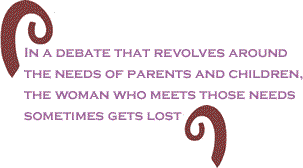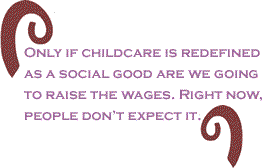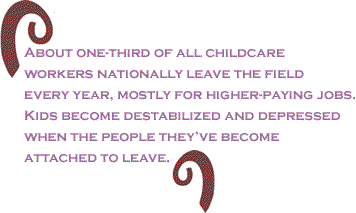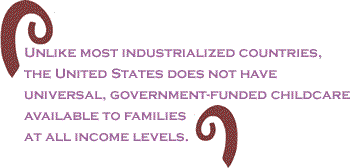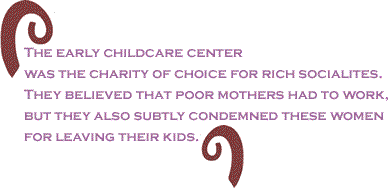
|
|||||||||||||||||||||
 |
|||||||||||||||||||||
 |
|||||||||||||||||||||
 |
|||||||||||||||||||||
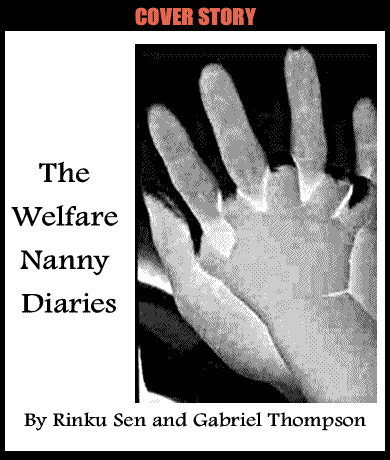 |
|
|
Sandra had only recently received her license to provide childcare, in 2001, when she first came across Khalid and his mother, Tanisha Watson, at the Jesse Owens Playground in Bedford-Stuyvesant, Brooklyn. The park had become an afternoon retreat for the five kids that Sandra was supervising, located two blocks from the house she shares with her mother. After working with youth at various agencies for the previous two decades, Sandra had decided to convert the first-floor apartment into a classroom and play area–naming it Kwame’s Place after her 10-year-old grandson–and was thrilled with her new job as neighborhood caregiver. Tanisha was exhausted, with good reason. She was working from midnight to 8 a.m. as a payments operator at Bank of America’s office in the World Trade Center. During the evening Khalid’s father stayed with the one-year-old, but when Tanisha got home the next morning, Khalid was rested and ready to play. She’d make breakfast, take a quick shower and head over to the park, struggling to keep her eyes open. "I watched Sandra for three weeks at the park before I spoke to her," Tanisha remembers. "She had such a rapport with the children that I figured she was their grandmother." Eventually Tanisha approached Sandra and learned that she was a childcare worker; Six months later, with a subsidy provided by the state for childcare, Khalid was the newest member of Sandra’s expanding family of little ones. "I’m already a statistic," says Tanisha, who is 26. "I’m young, Black, not married and with a child. Teenagers that get pregnant, it can feel like the end of the world, that things are never gonna get any better. But I decided that I wasn’t going to do that; I wanted to work and study. That’s why Sandra was such a godsend." By the time Khalid enrolled, Tanisha had switched jobs and signed up for evening classes at Long Island University, hoping eventually to become a teacher. "Some mornings I’ve had to bring him over at 5 a.m. Some nights now I get to her house after class at 10 p.m., and she’s already fed Khalid dinner and given him his bath. All I have to do is pick him up and put him to bed." With a new job at Beth Israel Hospital, Tanisha no longer needs the childcare subsidy. Still climbing the economic ladder since having Khalid, she’s grateful that someone like Sandra has been holding it steady from below. "I don’t know what I would have done without her," says Tanisha.
This is the story of the welfare nanny. She is the poor mother’s nanny–far more than a nanny in fact. Instead of working for a family in a luxurious Upper East Side apartment, Sandra walks down to three rooms in her mother’s Bedford-Stuyvesant home, where she performs the functions of caretaker, teacher, parent educator, advocate and referral service. Few things distinguish her from her clientele–they live in the same neighborhood, they are the same color and they’re all occupying the lower shelves of the economy. This army of cheap childcare providers counts almost 10,000 women in its ranks. They make it possible to call welfare reform an achievement in self-sufficiency. The government funds three kinds of childcare for the poor. Large daycare centers look the most like a traditional workplace, where the wages and benefits sometimes approach those of public school teachers. The next tier is the family daycare provider like Sandra, who sets up for 6 to 14 kids in her own home, is licensed and regulated, but with fewer training and educational standards than center workers. Finally, there is the informal provider, who is limited to two kids. Informals are unlicensed and largely unregulated. Wages in home daycare range from $1.10 to $6 per hour; annual salaries generally fall between $15,000 and $19,000. Providers are paid by the child, and regulations require keeping a small ratio of adults to children. Unlike the rich mother’s nanny, the poor mother’s nanny can’t go to her client and demand to be paid the minimum wage–it’s far more likely that she has to help her clients meet the basic necessities of life. Virtually all efforts to raise wages over the last 30 years have been tied to professionalizing the workforce. As one advocate says, "Polls show that people are more willing to pay for something called early childhood education than childcare." But little kids are always going to require that
the adults around them do more than teach. Children can’t feed,
water and clean themselves. They don’t know how to comfort themselves.
They can’t even learn to love themselves unless an adult loves
them first. Anyone working with kids is going to have to prepare
meals and wipe butts while dispensing hugs and compliments, whether
we call them nannies or teachers.
Americans have a vast, unending need for childcare. Fees on the open market can range up to $1,500 monthly per child, so the search for safe, quality, affordable childcare has become a necessary obsession, complicated by welfare reform and the increase in low-wage jobs. In spite of an almost $1 billion budget, New York City doesn’t even come close to meeting the need for government-subsidized childcare. The city pays for 68,000 slots in centers and home-based daycare; another 40,000 kids get unregulated informal care. Experts estimate that 150,000 low-income children still need childcare; 38,000 are on the current waiting lists. In a debate that revolves around the needs of parents and children, the woman who meets those needs sometimes gets lost. For her 12-hour days, for her compliance with daycare regulations, for the educational resources she pursues, Sandra is rewarded with an unstable salary that forces her to do a "constant juggling act" in order to make ends meet. She doesn’t have healthcare–a recent bout of strep throat meant she had to shell out $500. She laughs when asked about retirement savings. "I am now just breaking even," she says. A few of her parents pay out-of-pocket for her service, which helps land Sandra at the upper end of the provider earnings, making slightly more than $20,000 a year. She’s also lucky in that she hasn’t had any health scares. She recently heard about an uninsured provider who was diagnosed with cancer. "I would have gone bankrupt long ago if my parents didn’t buy this house in 1982," she says. "In this profession, it can be impossible just to earn the minimum wage." As she helps families escape poverty, who will push women like Sandra–and others faring even worse–back from its edge? It’s exhausting work, caring for other people’s children. One recent sunny morning, four kids are under Sandra’s supervision, and without interrupting a conversation, she heads off potential dangers and conflicts with the effortless grace of a veteran. If the adventurous Anthony, who will celebrate his 1st birthday within the month, decides to wander under the knee-high classroom table, there is Sandra, protecting his head with her hands. When the now 6-year-old Khalid and 5-year-old Ashley–who both just finished the school year–decide to roll a ball back and forth while seated on the floor, Anthony’s 2-year-old brother Bryan naturally wants to join in. Naturally, the older kids roll it past him, content to play keep away. Bryan lets out a cry. "Ashley, why don’t you roll the ball three ways?" Sandra gently suggests, hardly needing to glance up to know what the problem is. "Wouldn’t that make more sense?" Ashley looks over to Sandra and nods. At lunch, Khalid has discovered that the combination of fruit juice and spaghetti enables him to let fly with loud belches. "Excuse me," Sandra interrupts, "I know we’re not doing that, because that’s not cute." Khalid looks at her sheepishly, done burping for the day. And so on: When Khalid breaks a plastic photograph frame, Sandra jumps up from her chair and sweeps away the shards, holding a dozing Anthony in her arms. When Bryan hops around the room singing the ABC’s loudly, it is Sandra that shouts loud encouragement: "Sing it, boy! Sing it! That’s right Bryan!"
"I love this work," Sandra says. "Kids are so resilient; there is always hope. I don’t care what they’ve done or what they’ve suffered. They can come back from anything." One would forgive Sandra for having a less positive outlook. Before becoming a daycare provider, she spent many years working with abused and abandoned children and teenagers in New York and California, including youngsters who were already hardcore addicts and veteran gang-bangers. "I’ll never forget the first time I saw an example of such abuse," says Sandra. It was the 1970s, and she had just started a job as a youth counselor at an agency for at-risk boys. "There was a 7-year-old that the state had taken away, one of the few white kids. A parent had gotten angry and tossed him off the fire escape. You could see that he was actually a very sweet kid inside, but he also had so much anger. If you even took a checker from him, he would do this," and Sandra balls up her fists and her friendly face makes a frightening grimace. Last time she heard, the boy was in a Florida jail on attempted murder. "One of the reasons I decided to go into childcare is that you see how much damage has already been done by the time the kids are 6 or 7. I wanted to start younger." There’s another reason that she has spent most of her life caring for other people’s children. "I remember so clearly what it was like to be a kid. So I look at them and try to see how they are feeling about being a child. I’ll go back to that age when I’m playing with them," Sandra explains. She was born in Harlem and moved to the small town of Quincy, Illinois, when she was 5 to live with her great aunt, Mildred. Sandra’s mother, Shirley, had grown up in Quincy and decided that a few years of small town living would provide a healthy break from the city for her young daughter. Here, Sandra remembers that she could run free–"after doing my chores, of course"–and her only worry was to make sure to get back home before the streetlights turned on. "We had pigs and chickens in the back yard…it was country living at its best! I didn’t have a care in the world, but for so many kids these days, they can’t say the same thing. I guess that’s my main purpose: I want them to have the same opportunities to enjoy their childhood, to be loved and encouraged. To create a safe space for them to explore." Not that life in Quincy was perfect. The town had those notorious train tracks running between it, dividing it cleanly between white and Black, which left a lasting impression on the young Sandra. Her great aunt was a maid for one of the wealthiest white families, and so they had a relatively privileged position. Sandra attended a school on the "good" side of the tracks, one of only three Black students (and the only one whose dark skin meant she couldn’t pass for white). Still, Sandra remembers the disparities in wealth between the town’s segregated sections, and the unspoken Jim Crow code. "It was a lot like the South, with booths that only whites could sit in." She also remembers the racism–it was an epithet directed at her, after all, that eventually forced her to move back to Harlem.
Sandra doesn’t remember many problems early on in her schooling, which she attributes to the powerful position of her great aunt’s employer. That changed, though, in the seventh grade, when a girl called her a "nigger." "I don’t believe violence solves anything, but I have to be honest and say that I hit her when she said that," Sandra says. Not only did a Black girl strike a white girl–violence was supposed to flow in the opposite direction–but the daughter of her great aunt’s boss, who was the same age as Sandra, saw the altercation. "After that, my auntie said I had to leave. I think, more than anything, she was embarrassed about the situation." There’s a joke in the childcare industry. Q: Why did the childcare worker cross the road? A: To get to her other job. Selling fast food, preparing bodies for burial and cleaning the streets all pay more than childcare does. In New York City, there are two ways that providers like Sandra get paid by parents who can’t afford childcare. The kids whose parents make up to 200 percent of the poverty line are paid for by the Association of Child Development, a division of the Association of Children’s Services, which deals with child welfare. Those whose parents are on welfare are paid for by Human Resources Administration, New York’s welfare department. In either case, parents go to the agency and apply for a voucher, which they use to "buy" childcare. The city "reimburses" Sandra, at 75 percent of the private market rate, which is roughly $25 per day for a toddler. Every two years, the state is supposed to conduct a market survey, but there are often delays. The reimbursement rates were last raised in 2002, after 10 years of stagnation, only because providers filed a class action lawsuit. About one-third of all childcare workers nationally leave the field every year, mostly for higher-paying jobs. Kids become destabilized and depressed when the people they’ve become attached to leave. These arguments have put childcare salaries on the national agenda in a way that wasn’t true 20 years ago, but not enough to separate wages from what parents can afford to pay. It only takes an hour to see that the children, and parents, of Bedford-Stuyvesant are lucky to have a resource like Sandra at their disposal. "If you asked me, she should be making at least $50,000 a year," Tanisha argues. The care is evident within the walls of the center. The front room is overflowing with educational games and books, along with a crib for Anthony. In the second room, the walls are painted a cheery yellow, and a group of cut-out bunnies hops over one doorway, swimming ducks over the next. Multiplication and addition posters are taped to the walls. Above the charts are the names of each child. The only item on the wall that Sandra isn’t thrilled with is her daycare license, which expired in July 2005. New regulations put into place by New York State’s Department of Health mandated that all centers must have two means of exit that lead to streets–disqualifying a large number of home centers whose rear exit leads only to a back yard. After months of organizing and press coverage about the oversight, spearheaded by a Brooklyn-based organization called FUREE (Families United for Racial and Economic Equality), of which Sandra is a board member, the state eventually made an exception, allowing centers in homes that have backyards at least 50 feet long. Three different representatives from the Department of Health have come out to measure the yard "every which way" according to Sandra, but her application is still pending. Women of color and immigrants have a tradition of home-based daycare. This system operated almost as an underground economy until the 1980s when state governments began regulating it and providing subsidies for poor families to use it. Unlike most industrialized countries, the United States does not have universal, government-funded childcare available to families at all income levels. In 1971, President Nixon seemed poised to sign the Comprehensive Child Care Act, but he vetoed it as too "socialistic." In 1998, President Clinton unsuccessfully tried to move a $21 billion bill through Congress. The early childcare center was the charity of choice for rich socialites. They believed that poor mothers had to work, but they also subtly condemned these women for leaving their kids. Long application processes weeded out unmarried mothers and Blacks. Black philanthropists set up separate centers, but there were never enough to meet the need. So working women sent the kids to grandma, to an auntie or to a neighbor who kept several kids in her home. The government first funded daycare in 1940, when the Works Progress Administration set up Emergency Nursery Schools near industries that relied on a lot of female labor. During World War II, the centers expanded 100 percent, but most were dismantled as women lost their factory jobs to returning soldiers. Instead of childcare, the government opted to give widows a mother’s pension, recognizing motherhood as a patriotic service. Pensions were first introduced in 1934 and became the basis for Aid to Families with Dependent Children, better known as welfare. The motherhood ethic kicked in again in 1954, when Congress focused the new childcare tax credit on the poor because conservatives resisted giving middle-class women an incentive to work. Blacks and Latinos were cut off from welfare for 40 years, either by exclusions in the original law (for example, barring agricultural workers, which included the vast majority of Blacks and Latinos until the 1960s) or by discrimination at welfare offices. When the National Welfare Rights Movement fought for Black women’s right to stay home in the late 1960s, the numbers of women of color receiving welfare started to rise. By the 1990s, when both Newt Gingrich and Bill Clinton were eager to end welfare as we had known it, women of color were disproportionately represented on the rolls. In 1996, Congress crafted welfare reform to put even women with infants and toddlers into training or workfare programs. Since childcare was an obvious barrier, Congress expanded the childcare allocation and allowed states to use welfare surpluses for childcare. By law, no recipient can be forced into a work program or cut off from benefits because she can’t find safe, convenient childcare. Meanwhile, the color and character of the childcare workforce changed rapidly. Marcy Whitebook, a leader of the childcare workers living-wage movement for 30 years, says that the workforce started to change in the 1970s, when white, college-educated women got the chance to escape traditional women’s work. Rapid immigration and welfare reform also contributed. "New immigrants generally get the jobs that are the lowest status and lowest paid, and some women were being urged to come from other countries to do that work," says Whitebook. "Then we needed childcare for women being pushed off welfare, needed to expand that low-wage industry. You couldn’t do it with centers, you had to do home-based care to get it up and running fast enough." Because publicly-funded childcare is seen as exclusively for the poor, Americans don’t expect childcare benefits the way they’ve come to expect other government benefits that are broadly available to everybody, like public education or libraries or parks. "Only if this is redefined as a social good are we going to raise the wages. Right now, people don’t expect it," says Whitebook. A universal system of publicly funded childcare is the only olution with the potential to decouple childcare wages from what parents can afford to pay, mostly because it would send a massive influx of money into the system. Joan Lombardi, who served as Clinton’s childcare bureau chief, says that government funding "puts a third party into the system, which we know historically has helped to raise compensation." The third party would ensure care, as there is in public education, Medicaid or even the system of private health insurance. Sandra is more than a top-notch childcare provider–she presents a different parenting model for many neighborhood residents. "Too often, we think that we need to hit our kids to get them to behave. But I’ll never forget what one of my psychology professors told me when I was taking college classes. He said, ‘When parents hit the kids, it’s not the child that is acting up–it’s the parent.’"
Many parents feel that they must always be loud and domineering to gain respect, says Sandra, and this philosophy can often include corporal punishment–a practice that can blur into, and encourage, child abuse. Recently, the issue of child welfare has became a much-discussed topic in the wake of the death of a seven-year-old girl named Nixzmary Brown, allegedly killed in January by her stepfather in her Bedford-Stuyvesant home. Two investigations, spurred by complaints about Nixzmary’s home environment to the Administration for Child Services, were launched within the previous year, without effect–which led to several firings and calls for an agency overhaul. But before Nixzmary’s death, Sandra was already maintaining a vigilant watch. When a new child enrolls, she likes to sit down with the parents and explain her simple philosophy: "Children need dialogue, they don’t need to be whipped." When parents see how Sandra is able to command respect without resorting to physical force, they are won over, though it has sometimes been a difficult process. "All I ask is that they meet me halfway," Sandra says. "So far, every parent has been able to do that." One parent in particular felt that corporal punishment was a critical parenting tactic.That has since changed. "Oh yeah, I was able to get her to see different," Sandra laughs. "I don’t want to come across as judgmental, but my message is simple: this is not acceptable." The parent had come into the daycare often yelling and threatening to beat her child. "Now her approach is completely different," Sandra says, "All you have to do is show parents that there is another way." On another sweltering June day, Sandra is back at the park, this time with six children. The fountain is shooting water high in the center of the park, and Bryan is hopping around under its arch, shouting an announcement to Sandra over and over again. "I wet! I Wet! I WET!" "That’s right Bryan, you wet!" Sandra giggles. "Can you believe I get to do this as a job?" she asks. "Hang out all day with kids, playing. And I mean playing with them! Don’t even know if I could go back to the real world now. I’m lucky that my mom owns her house, ’cause Lord knows I’m not gonna get rich doing this." She pauses to acknowledge Bryan with another smile as he continues his chant. "But I’m rich in other ways. Be doin’ this till I die." Sandra knows other providers who have had to switch jobs, unable to meet their barest necessities–though they’re doing perhaps the most important job one can do for low-income families. Watching her play with the kids as they splash around in the middle of a gritty neighborhood where drugs and gangs are never entirely out of reach, it’s clear that even if she were paid $50,000–approximately three times the typical earnings of providers–our country would still owe women like Sandra more than we can pay. Rinku Sen is the publisher of ColorLines. Gabriel Thompson is the author of “There’s No José Here”. REPRINTED WITH PERMISSION: ColorLines magazine, www.colorlines.com |
|
| Home | |
Your comments are always welcome. Visit the Contact Us page to send e-Mail or Feedback or Click here to send e-Mail to [email protected] e-Mail re-print notice
If you send us an e-Mail message we may publish all or part of it, unless you tell us it is not for publication. You may also request that we withhold your name. Thank you very much for your readership. |
|
| October 19, 2006 Issue 202 |
||||||||||||||
|
||||||||||||||
|
||||||||||||||
| Printer Friendly Version in resizeable plain text format | ||||||||||||||
 |
||||||||||||||
 |
||||||||||||||
 |
||||||||||||||
 |
||||||||||||||
| |
||||||||||||||
| |
||||||||||||||





















